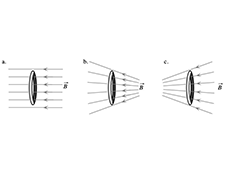
Lenz' law
Variant i Dynamics first
Motivates Lenz’ law and helps students apply it. They recognize that F = qv × B cannot always be used to determine if there will be an induced current through a conducting loop.
Topics Electricity and magnetism / Magnetism: models, symmetry, systems, vectors, magnetic fields, and surface area
Materials
Materials by the UW team
- Instructor Guide


- Pretest


- Exam Questions



- Equipment List

Tutorial details
Students begin by reviewing important skills and concepts developed in previous tutorials, particularly Magnetic interactions. Emphasis is placed on student reasoning. Students work through situations in which they determine the direction of induced current in a wire loop placed near a solenoid. The first several examples involve relative motion between the loop and solenoid, allowing students to employ F = qv × B. Students reflect on their findings from these two examples and recognize that the flux due to the induced current always opposes the change in flux due to the external magnetic field. At this point, students are asked to check their answers with a tutorial instructor. Students often need guidance in completing a correct chain of reasoning. Many are unsure how to correctly define the area vector in the experiments described.
In section II of the tutorial, students generalize the rule developed in section I and formulate Lenz’ law. They apply Lenz’ law to a situation involving a time-varying magnetic field, and to a loop moving into and then through a region of uniform magnetic field.
For instruction tips, login or register as a verified educator to see the Instructor Guide.
Prerequisites
The tutorial assumes that students have worked through several of the previous tutorials.
Students must be familiar with the magnetic force F = qv × B on moving charges, the magnetic field of a solenoid, the magnetic moment of a current loop, and how magnetic objects interact with other magnetic objects. No prior knowledge of Lenz’ law is assumed.
Coming Soon! We hope to release the discussion section on each tutorial soon.

